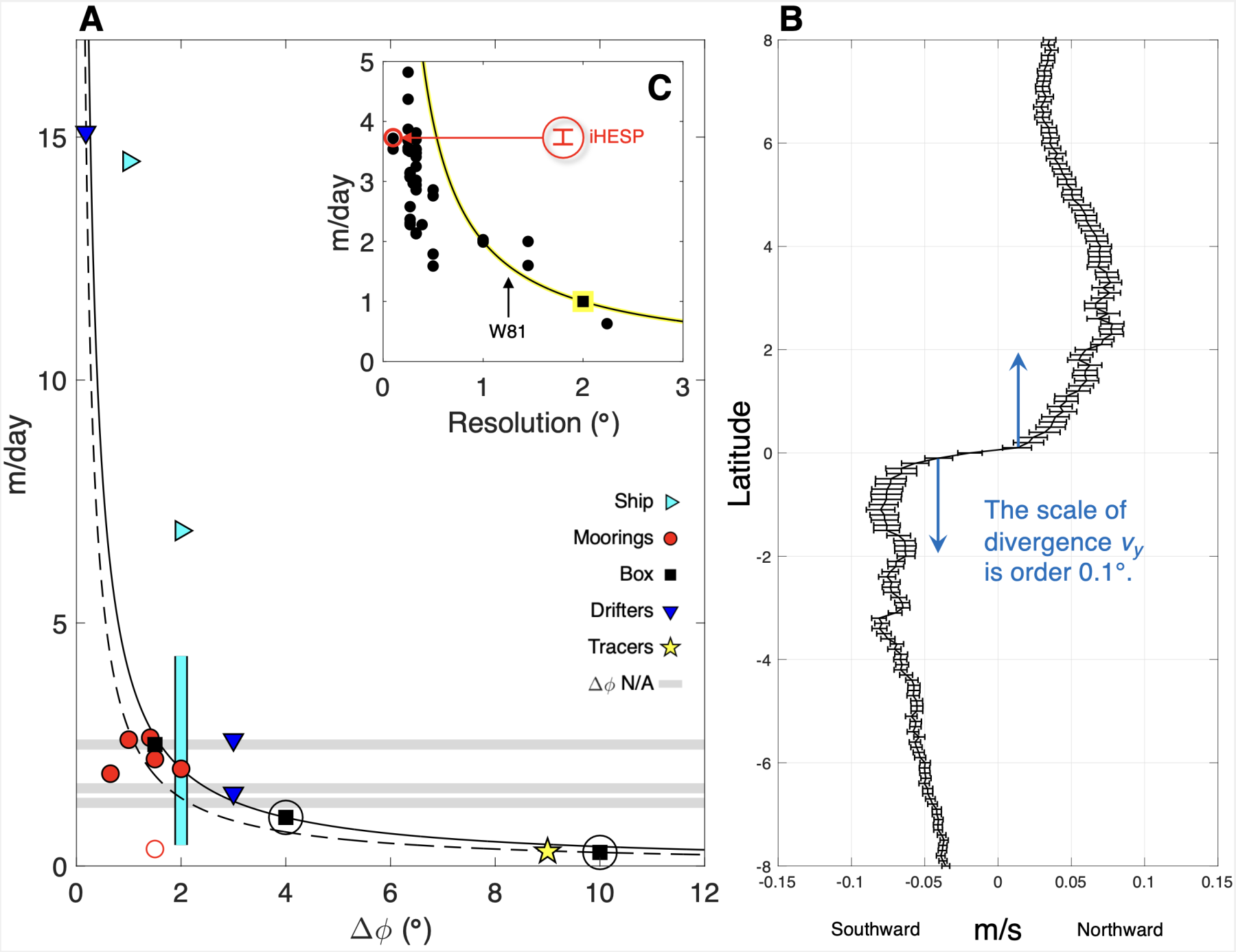A new observational benchmark for equatorial upwelling
Upwelling in the equatorial Pacific Ocean is important locally by impacting sea surface temperature (SST) and chlorophyll, and globally through impacts on climate and the carbon cycle. Despite the relatively simple explanation for the Eulerian mean upwelling velocity offered by Ekman in 1905, observational estimates of its magnitude vary considerably—from 0.3 to 15 meters per day. Any informal survey would suggest that the most memorable estimate is 1 m/day, given in 1981 by the late Klaus Wyrtki.
Published recently in the Journal of Climate, Karnauskas (2025) re-examined a collection of historical estimates made since 1961, as well as drifters and other modern observations and state estimates, to provide new constraints on this key variable. A popular method to estimate upwelling is to measure poleward velocities on both sides of the equator and integrate the continuity equation. When plotting the historical estimates as a function of distance between the measurements on either side of the equator, there is an extraordinarily clear nonlinear relationship such that the closer to the equator the velocity measurements were made, the greater the divergence and inferred upwelling velocity (Figure 1, A).
This re-examination of historical estimates suggests that most of them may have underestimated the peak time-mean velocity. It also implies that a very dense sampling of observations is needed near the equator to resolve it. Since 1979, there have been about a million observations of near-surface velocity made within 8° of the equator by the NOAA Global Drifter Program—a clear opportunity. Karnauskas (2025) zonally averaged all of the measurements from the eastern equatorial Pacific in 0.1°-wide bins, which exposed the remarkably sharp divergence at the equator (Figure 1, B). By continuity, the inferred upwelling velocity is 13.1 ± 6.9 m/day. Drifter sampling in the equatorial Pacific increased steadily from the 1980s to the early 2000s when most years had more than 2,000 measurements within 1° of the equator. Using only the years in which that threshold was met (which represents the top 20% sampling years), the estimated upwelling velocity increases to 16.4 ± 9.8 m/day.
Vertical temperature advection by the mean equatorial upwelling is the engine behind one of the seminal theories for how SST in the tropical Pacific responds to radiative forcing. Indeed, all CMIP6-generation models severely underestimate the mean equatorial upwelling velocity including a significant correlation with ocean model resolution (Figure 1, C). Karnauskas (2025) argues that our (and our models’) general tendency to underestimate equatorial upwelling velocity may offer a clue into the stark disagreement between historical trends in the Pacific zonal SST gradient and climate model simulations thereof.

Figure 1. (A) Historical upwelling estimates as a function of meridional scale, defined as the distance (in degrees latitude) between the two points of measurement. Solid black curve is based on the Wyrtki (1981) estimate (circled marker at 4°). (B) Zonal mean meridional velocity in 0.1° by 60° bins (160°W–100°W) for all 905,384 NOAA drifter observations in this domain since 1979. (C) Time-mean, zonal mean vertical velocity versus ocean model resolution in CMIP6 climate models. Yellow-highlighted features represent the Wyrtki (1981) estimate. Red features represent the iHESP ensemble mean and its full range (error bars offset for clarity). Adapted from Figs. 2, 4B and 9C of Karnauskas (2025). See full paper for more details and complete captions.
Karnauskas, K. B., 2025: How fast is the mean upwelling in the Equatorial Pacific Ocean? J. Climate, https://doi.org/10.1175/JCLI-D-24-0704.1.
Topics
- Climate Change
- Ocean Heat
- Pacific Ocean
